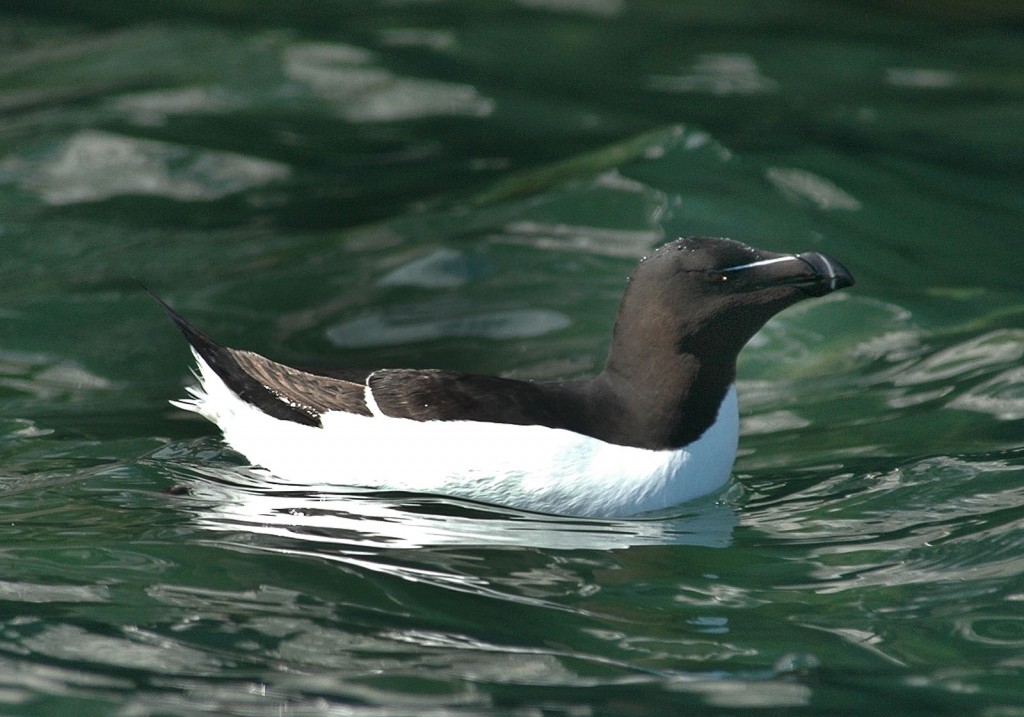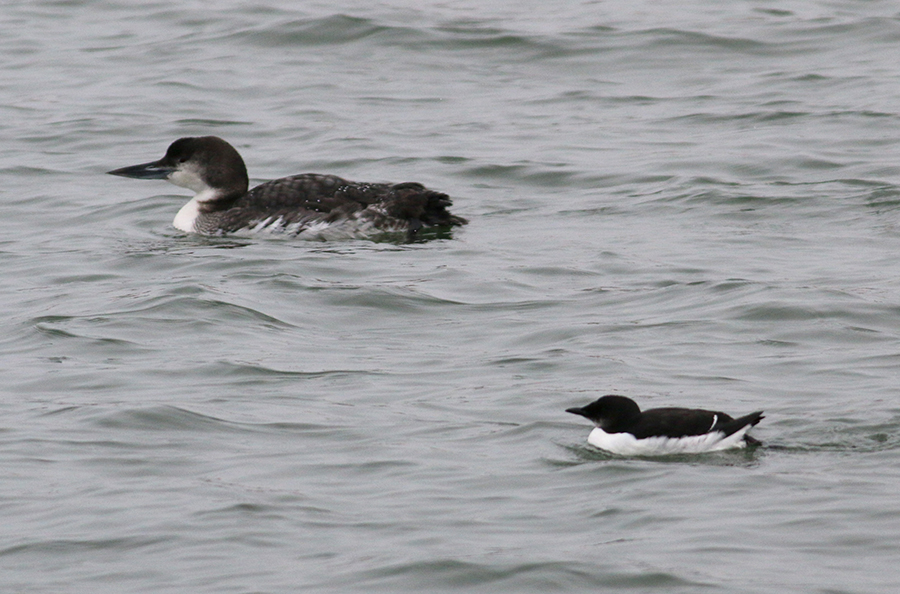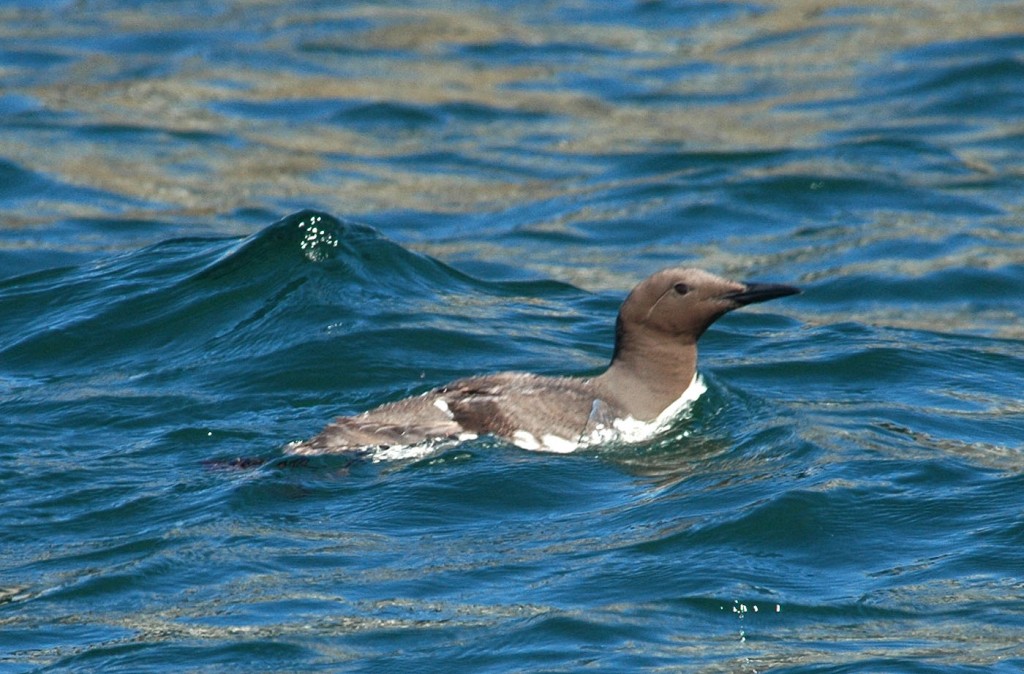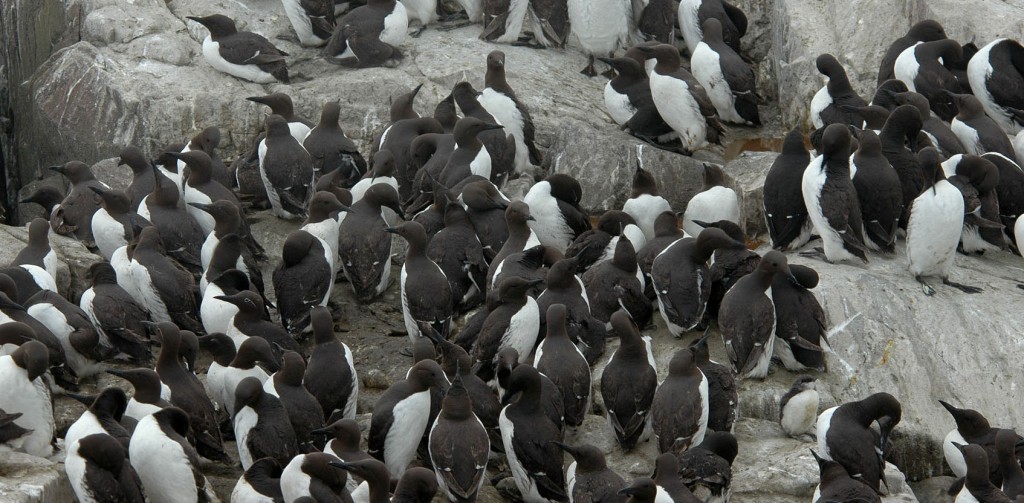A highlight of winter birding for me is looking for alcids. Sighting any member of this family of birds from land feels special because alcids spend most of their time in the open ocean. One drawback, however, is that sightings can often be less-than-optimal, either from a distance or of birds quickly flying past offshore. Because sightings can be fleeting, it is beneficial to know which alcids can be expected to appear in your area and to be prepared on how to distinguish them. I just completed my annual personal alcid refresher session, and thought it might be useful to share some general features of the alcids, and then focus on those that can been seen in my home turf of New Jersey.
The alcids are a relatively small family, with only 24 species world-wide, 21 of which occur in North America. They are strictly a northern family, not normally found south of the equator. Although most birders would probably guess that they are most closely related to penguins, they are actually more closely related to gulls. They have a completely marine lifestyle except for breeding on land. Interestingly, alcids have diverse breeding strategies, with puffins nesting in burrows, murres and Razorbills nesting on steep cliffs, Kittlitz’s Murrelets nesting on open tundra, and Marbled Murrelets nesting in trees. They are extremely proficient divers that rely on their wings for propulsion, like some ducks (Long-tailed Ducks, Eiders, and Harlequin Ducks), but unlike loons and grebes, which use their feet for propulsion. Their wings therefore are relatively short and stubby, well-designed for underwater ‘flight’, but ill-equipped for soaring. This adaption results in flights that are typically low to the water and consist of continuous wingbeats. Most alcids are counter-shaded, being mostly black on top and white below. Putting all of this together, any time I am near the shore in winter I look for smallish short-necked low-flying birds with black uppersides and white undersides that together should distinguish them from any grebes (which are not often seen in flight), loons (which are much larger), or ducks. Although these characteristics describe the family in general they don’t allow distinguishing the species. So once we spot an alcid, how do we begin to distinguish them from each other?
First of all, it is extremely useful to know that only seven alcids have been seen here in New Jersey, greatly simplifying the problem, and only five are very likely from land. A reasonable place to start is with relative abundance; which species are we most likely to find? Of the seven NJ alcids, Razorbill is by far the one most frequently observed from land, followed in frequency by Dovekie, Thick-billed Murre, Common Murre, and Black Guillemot. At the other end of the spectrum, Atlantic Puffins are rarely sighted from land, and Long-billed Murrelet has only been seen once in the state.
A second useful criterion is size. The three largest species (Thick-billed Murre 18″; Common Murre 17.5 “; Razorbill 17″) are in a similar size range as Red-necked Grebe (18″) or Black Scoter (19″), while the next two (Black Guillimot 13″; and Atlantic Puffin 12.5″) are in the same size range as Bufflehead (13.5″). At 10″, Long-billed Murrelet is noticeably smaller than Bufflehead, while Dovekie, at 8.25” is tiny, being the same size as a European Starling. Imagine trying to find a Starling floating on windy seas! Being able to estimate the size relative to the more familiar loons, grebes, or ducks in the area is a great start to the identification process.
Beyond size, what other features can we look for to distinguish these species? Most birders would rely on plumage, but with the exceptions noted below, plumage of most alcids doesn’t help me very much because most of them are black on top and white below with a white neck. So I like to focus on structure: the size, shape, and proportions of the bird. Let’s start with the most common candidate. Razorbill has a longer tail than the other alcids, extending the same length as the legs, resulting in a symmetrical, football-like appearance in flight, unlike the similarly-sized murres, where the legs extend beyond the tail. At close range, its broad bill with both horizontal and vertical white lines is distinctive.

Razorbill in breeding plumage. The blunt bill with its horizontal and vertical white lines is distinctive at close range.
Distinguishing between the murres is a challenge, since they have relatively similar plumage patterns. Thick-billed Murre is seen more frequently from shore than Common, has a blacker head, and tends to hold its bill level. It’s a heavier pot-bellied bird, so it has labored takeoffs from water. Common Murre is less common from shore than Thick-billed, has a browner head and back, and its bill tends to be held pointing upward. In winter, it has more white on the face than Thick-billed. That combination of whiter face and upturned bill makes it Red-throated Loon-like vs. Thick-billed with its level bill and darker face being Common Loon-like.

Thick-billed Murre with a Common Loon, showing the extreme size difference. Even though Thick-billed Murre is our largest eastern alcid, it is not even close to being loon-sized.

This photo of a Thick-billed Murre from Manasquan Inlet nicely shows how the longer legs protrude beyond the body. For a Razorbill, the legs extend only to the tip of the tail.

Common Murre has a noticeably browner head and back, although perhaps not always as evident as this specimen, which is from breeding season.
Dovekie is best distinguished by its tiny size and short blunt bill. They have proportionately long wings for an alcid, and because it is not very heavy, it takes off quickly from water. Its wingbeats are too fast to count or even to see. For these reasons, Pete Dunne cleverly refers to Dovekie as ‘The Bumblebee Alcid”.
Black Guillemot has the most distinctive plumage of the alcids, at least in winter when most of us get to see them. It is a pale bird, with a mostly white face and body, and large white wing patches all year. It can be seen most often on rocky coasts, where it prefers to forage. Its red legs are visible in flight.

Black Guillemot in winter. It is the only eastern alcid that is mostly white in winter. Photo by Dave Koehnlein.
Atlantic Puffin is the most recognizable alcid, at least with its oversized bright orange bill and orange legs that should be obvious in flight. It is the only eastern alcid with a black throat/collar year-round, unlike the other alcids, which have white throats in winter. Puffins like deep water of the continental shelf, so they are unlikely to be seen from shore, except perhaps after storms.

The Atlantic Puffin is unmistakable at close view. In flight, its orange bill and feet stand out. Notice its black neck, unique among our alcids in winter.
Keep an watchful eye out for this interesting group of birds. Because they are relatively uncommon, it can take some effort to find them. I have taken to sitting patiently on a folding stool at inlets in winter, scope at my side, especially on more tolerable warm and calm winter days, ideally after easterly winds have blown birds landward. Maybe I’ll see you there too.

